After a survival win against Celta de Vigo on Thursday, Barcelona faced a huge challenge against Sevilla. Both teams had won the two previous games in La Liga and are expected to be fighting for the title until the end of the season. Sevilla came with the motivation of an agonizing win in the 92nd minute against Levante and looked to expand their unbeaten run in the league to three matches.
The match ended in a fair 1-1 with both teams being very balanced. Julen Lopetegui’s well-established tactics limited Koeman’s and the draw was a good result for both sides. In this tactical analysis, we will look at the key aspects of this game.
Lineups
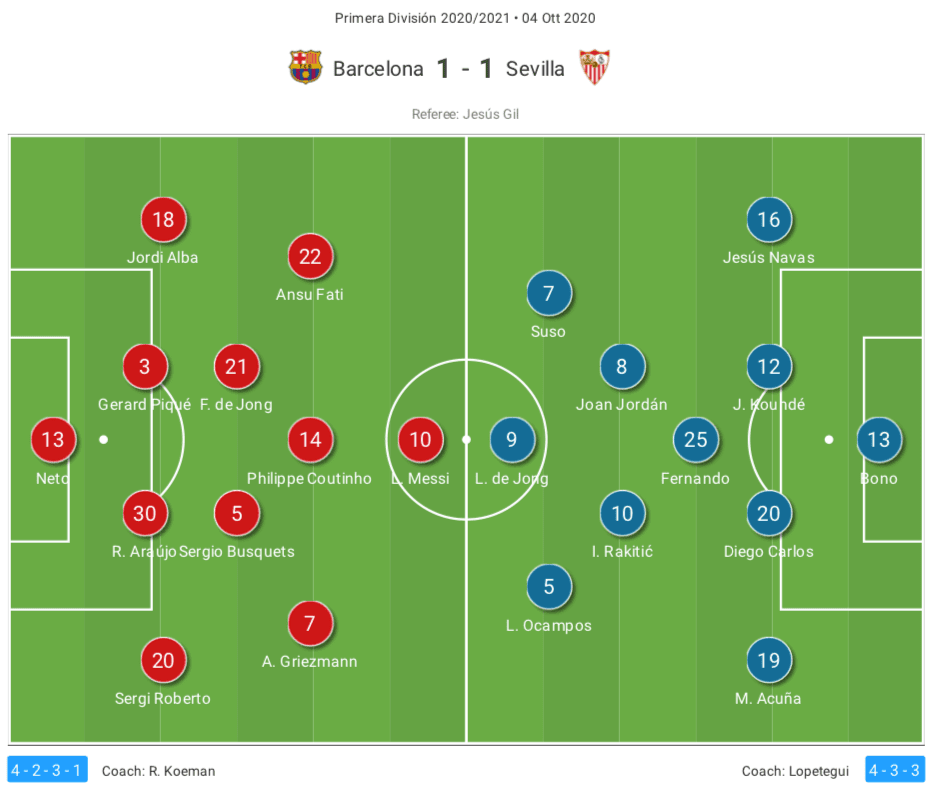
Ronald Koeman chose to repeat his starting lineup for the third time in a row except for Ronald Araújo, who substituted Clément Lenglet, sent off in the match against Celta. This change also made Piqué move to the left centre-back position. Apart from the centre-backs, the team was the same: Neto; Sergi Roberto, Ronald Araújo, Gerard Piqué, Jordi Alba; Sergio Busquets, Frenkie De Jong; Antoine Griezmann, Philippe Coutinho, Ansu Fati; Lionel Messi. The new right-back Sergiño Dest was on the bench waiting for his debut.
Sevilla did introduce some changes. Recently signed Marcos Acuña started in the left-back replacing Escudero and forming the defensive line with Jesús Navas, Jules Koundé and Diego Carlos. The midfield trio was the expected Fernando, Ivan Rakitic and Joan Jordán. In the attack, Suso came in for Munir and Luuk De Jong was chosen instead of Youseff En-Nesyri, both of them forming the attacking line with Lucas Ocampos. Choosing De Jong instead of En-Nesyri proved Lopetegui looked to dominate the game and not to counterattack.
Barcelona’s lack of energy and threat between the lines
Barcelona arrived at the game after an exhausting midweek fixture against Celta de Vigo, in which the Catalans played with ten more than 45 minutes and still won 0-3. Against Sevilla, the players seemed tired and lacking energy. Being a team under construction against one of the most established teams in La Liga, it was normal that Barcelona struggled to play at a high level for the 90 minutes.
Lenglet’s sanction affected Barcelona’s game, especially in the buildup, as Piqué had to move to the left centre-back position and Araújo, less technically gifted than the other two, occupied the right side of the defence. Probably because of this, Alba acted a lot of times as the left centre-back when playing from the back, looking to have a left-footed player who could break lines with his passing. It was De Jong who was in that position in previous matches, but in this game, he and Busquets were in front of the defensive line most of the time.
This tactical change made Barcelona lose the width and depth Alba usually provides when he acts as a wing-back. The left-back still tried to appear in the attacks, but he started the plays from a very deep position, so couldn’t appear in the final third as often as we are used to, and he was the third player with the deepest average position just behind the centre-backs.
We can see Alba’s positioning as the left centre-back in the buildup in the next picture. Roberto and Fati provide the width and the two central midfielders are in the same line. This made Barcelona’s left-wing lose threat as both De Jong and Alba couldn’t play as near to Fati and Coutinho as in previous matches.
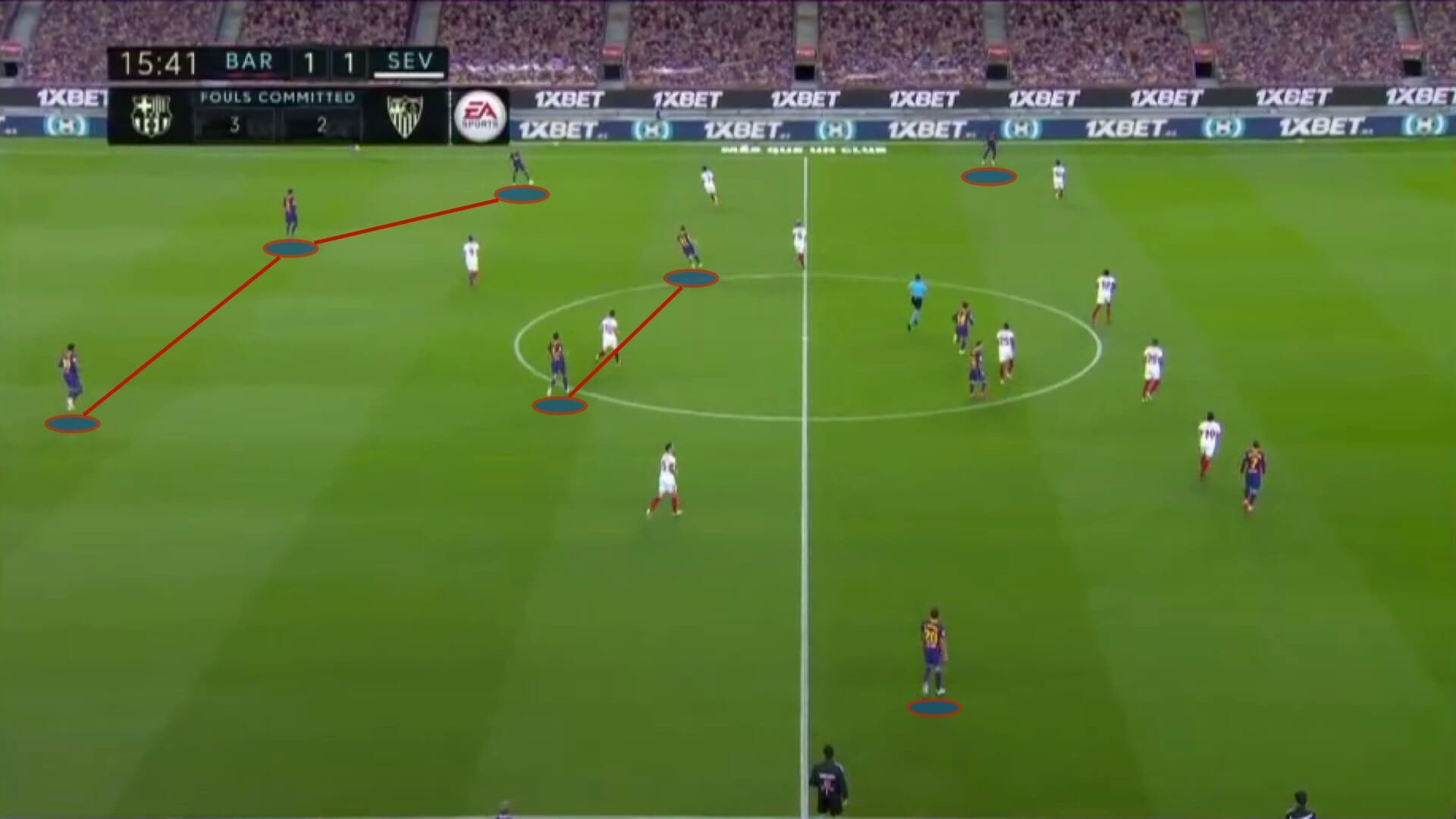
Compared to previous games, Barcelona also lacked presence between the lines. Sevilla defended very well and Barcelona players, especially Messi and Coutinho, tended to come and get the ball in very deep positions instead of waiting patiently for their team to find them between the lines.
It’s also true that Barcelona struggled to break lines with their passes, so the quality players tried to solve this but at the cost of leaving dangerous positions closer to the goal. Without Lenglet, Piqué didn’t play in his natural side, so a pass from the centre-back couldn’t find players behind Sevilla’s midfield. Also, De Jong was erratic and didn’t have as much space as he did in previous matches when he was in charge of collecting the ball from the centre-backs.
In the image below we see an example of the lack of players between the lines. With both Busquets and De Jong sharing the defensive midfielder zone and the four attackers staying high, no one offered passing lanes behind Sevilla’s pressure, so Barcelona was often forced to play long balls.
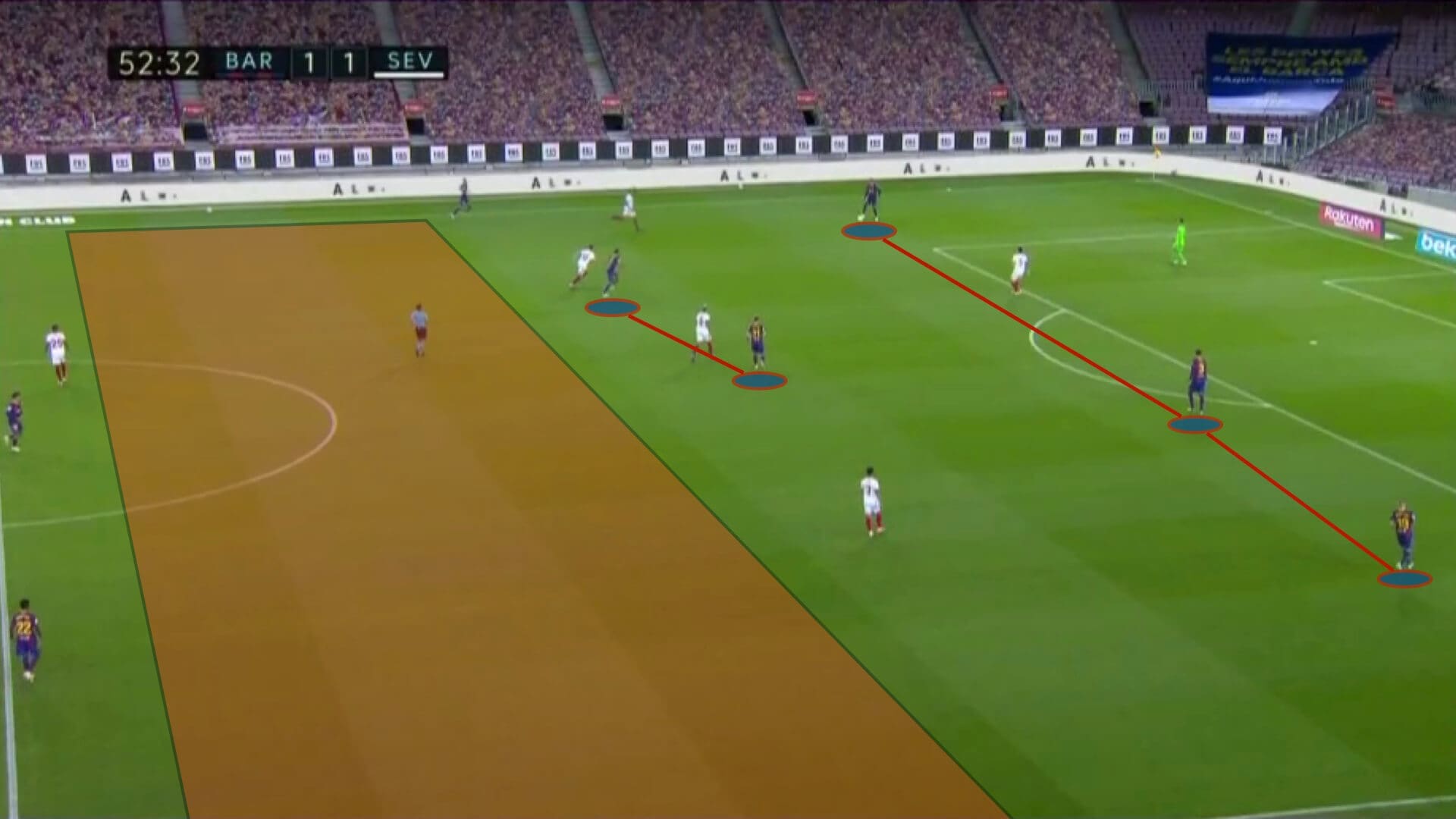
In positional attacks, Barcelona suffered the lack of width and presence between the lines we have seen so far in this tactical analysis. Sevilla played a major role in forcing this with their defensive setup. Barcelona’s attackers changed positions often, especially Coutinho and Messi, with Griezmann working very hard off the ball but with little reward. Only Fati remained in his original position, but this time he wasn’t as supported as in previous games and couldn’t affect the game.
Barcelona’s goal actually came when Alba made a run in behind and Messi tried to find him with his trademark pass. A mistake in the clearance by Navas left Coutinho with an open goal. With more runs like this on the left-wing, Messi would have felt much more comfortable and Fati could have exploited the spaces better, but Alba’s role and Sevilla’s threat from the right-wing limited the appearances of the left-back in the attacking phase. Barcelona attacked mostly from the centre, where Sevilla were very strong and didn’t allow much to happen, limiting the Catalans to just 0.93 xG in total.
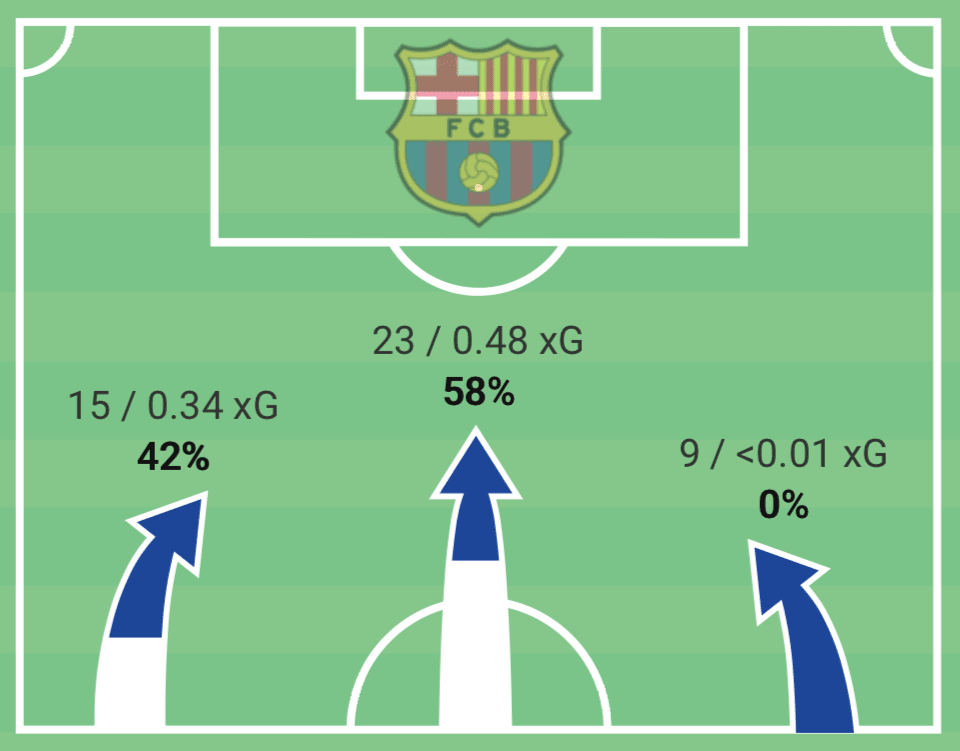
In defence, Barcelona also lacked the energy they showed in the first two matches of the season. They used a high block but didn’t really show aggression to recover the ball. They just tried to force mistakes in Sevilla’s buildup. This pressing was effective at some points but wasn’t consistent enough and Sevilla found ways of playing through it.
A new feature in Barcelona’s press was the three midfielders – Coutinho, Busquets and De Jong – man-marking Sevilla’s midfielders. Even when Fernando, the defensive midfielder, changed positions with Rakitic or Jordán, Coutinho still followed him, so it wasn’t strange to see the Brazilian as the deepest midfielder in the defensive phase, with Busquets and De Jong pressing higher and marking Rakitic and Jordán.
That’s exactly what we see in the next picture. Fernando leaves the defensive midfielder position in a well-trained move we’ll analyze later on in this analysis and Coutinho follows him, occupying the defensive midfielder position at some points.
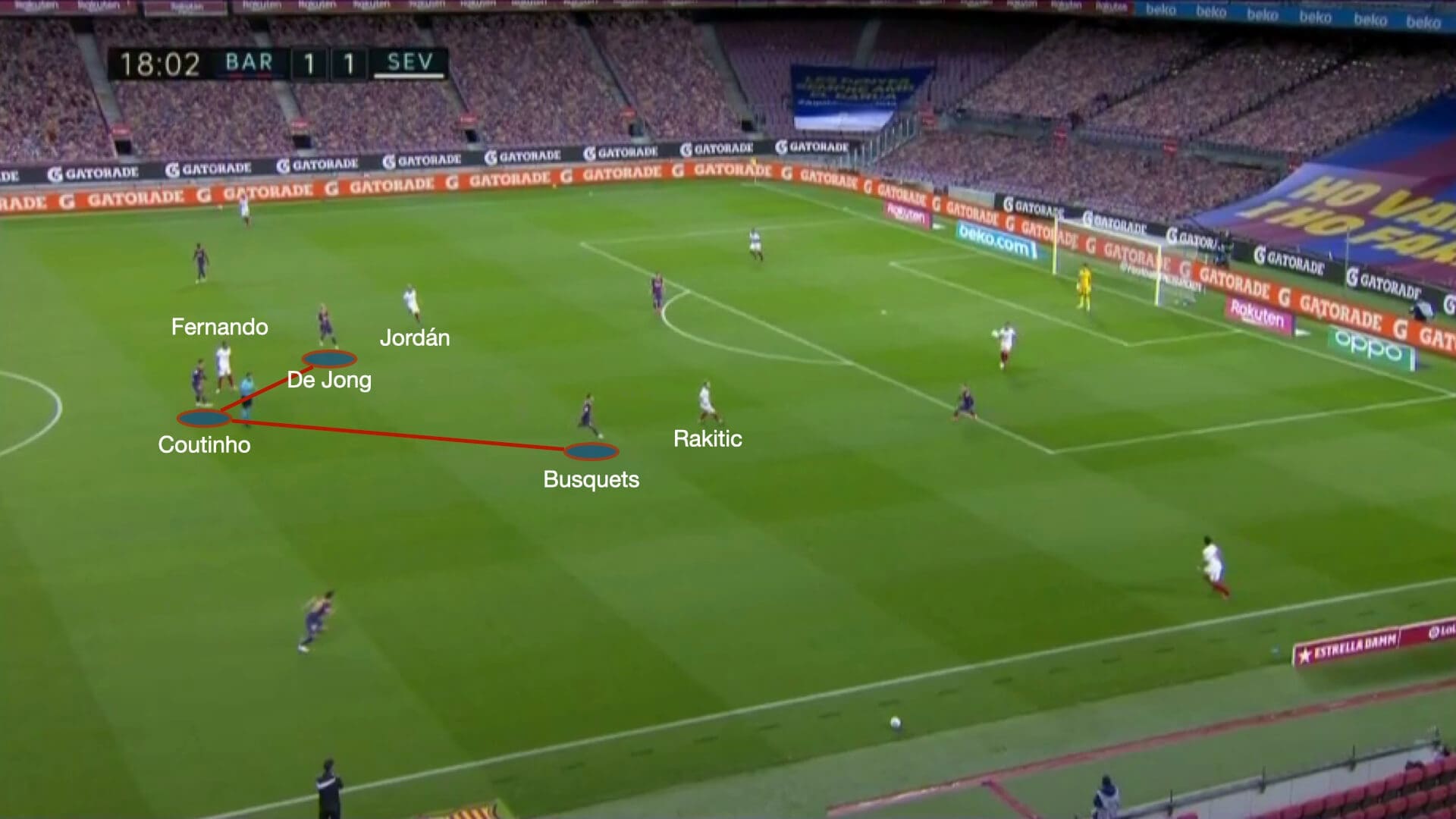
Barcelona also tried to force Sevilla to play to the left side, where Roberto pressed aggressively leaving Piqué and Araújo in a 2v2 situation with Sevilla’s Ocampos and De Jong. Barcelona had Alba and De Jong on the left side, so they could use their pace to defend the long balls Sevilla used to avoid this trap.
In the next sequence, we can see how Barcelona tried to press. Sevilla’s left-back Acuña was left free and Roberto pressed him once the pass was played. In the second picture, Sevilla have managed to play a long ball to the opposite side. Both Piqué and Araújo are on the right-wing marking Luuk De Jong and Ocampos, so it’s Frenkie De Jong and Alba who must use their pace to defend the spaces left.
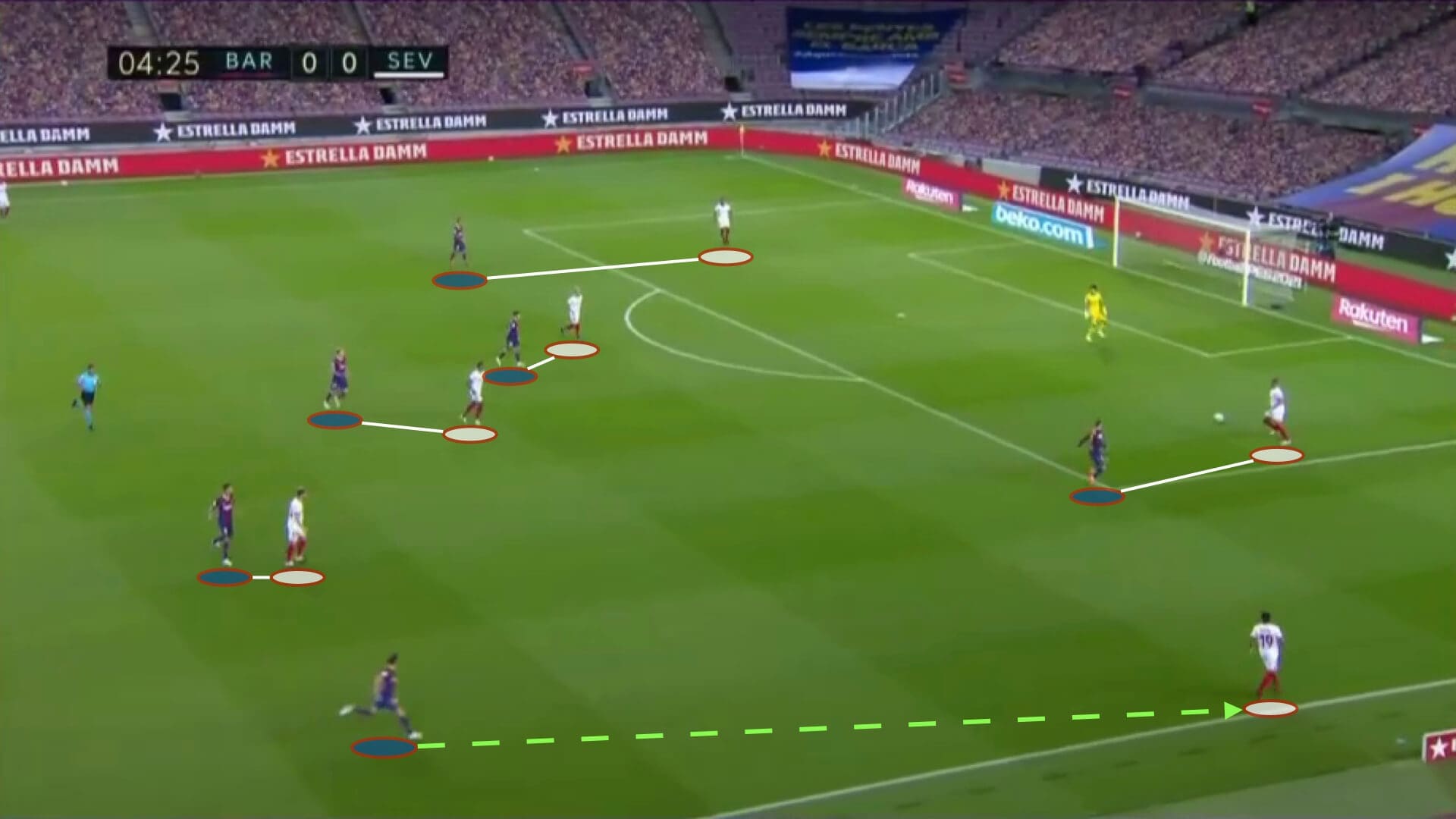
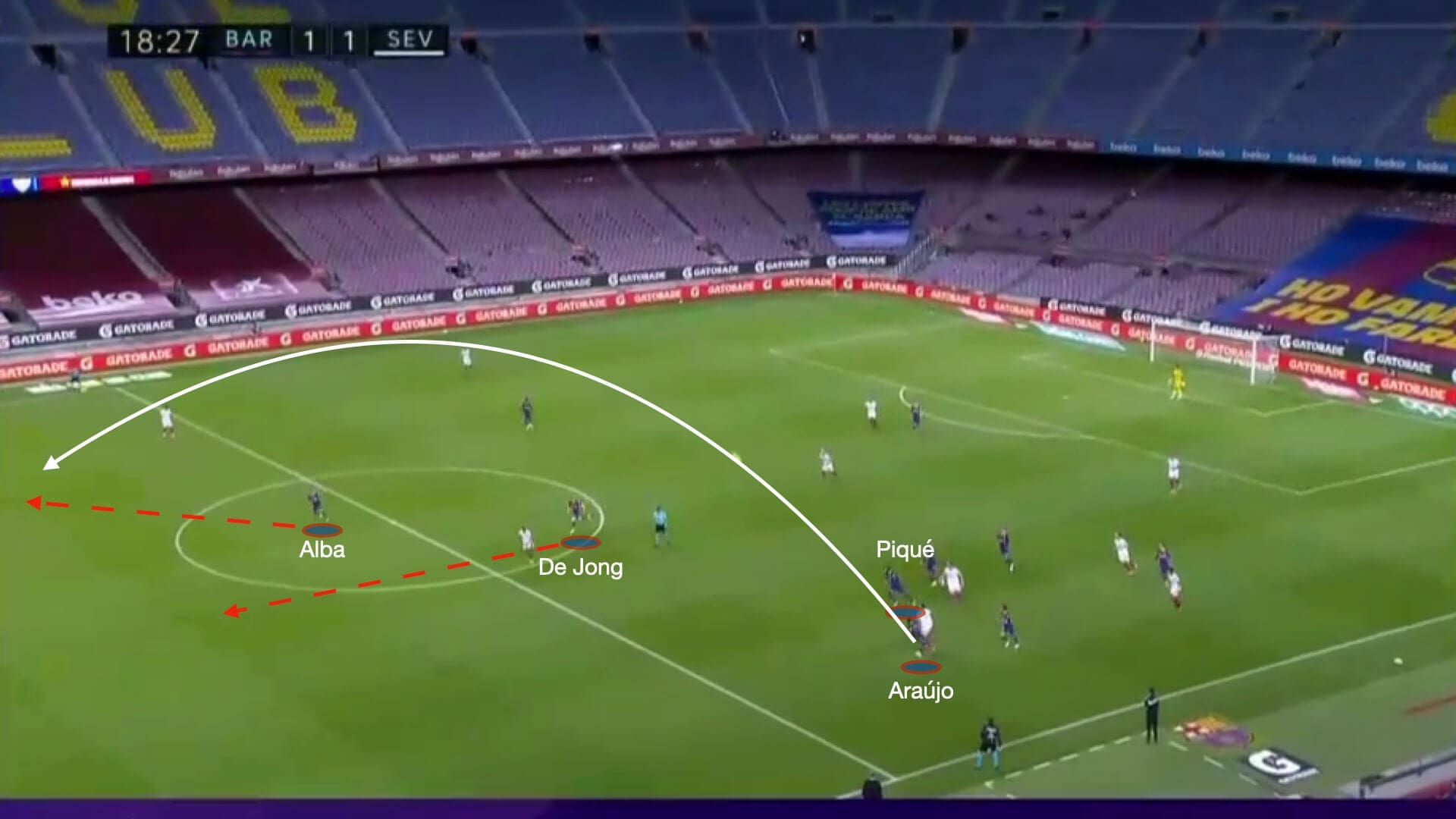
This dependence on Alba’s pace to defend Sevilla’s long balls made the left-back stay back more often than usual, harming Barcelona’s attacking possibilities and leaving Fati too isolated upfront.
In the last part of the game, Ronald Koeman tried to change the game with four substitutions. Trincão, Pedri, Pjanic and Dest substituted Fati, Griezmann, Coutinho and Alba (injured). Trincão was the right-winger, providing width and depth on that side; Pedri started as the attacking midfielder and then moved to the left; Pjanic was the central defensive midfielder, with Busquets moving to a more advanced right central midfielder position and De Jong to the attacking midfielder position. Dest made his Barcelona debut as the left-back because of Alba’s injury.
In the last 15 minutes, Pedri and Trincão plus De Jong from his new more advanced position gave Barcelona energy when pressing. Barcelona averaged 20 opposition passes per defensive action between the halftime and the 75th minute, and in the last 15 minutes, they lowered that to 16. In the same period, Barcelona increased their attacks per minute from 0.20 to 0.65 and also produce their best chance in the game, when De Jong missed a chance worth 0.27 xG in the 82nd minute.
Sevilla’s defensive versatility and set pieces threat
Sevilla came to the Camp Nou with a well-studied plan. Julen Lopetegui’s players always seemed to know what to do and their versatility both in attack and defence was key to control the game and limit Barcelona’s options.
When playing from the back, Sevilla opted for short passes, inviting Barcelona to press them to play long passes to the other side of the pitch afterwards. We saw an example of this before when analyzing how Barcelona pressed Sevilla. In general, Sevilla players didn’t take many risks in their own half and just passed the ball between them until they attracted Barcelona’s pressure.
One of the aspects Sevilla dominated and which was crucial in this setup was the aerial duels. The Andalusian side only lost 33% of the aerial duels and it was a key aspect for them as it helped the team win second balls and continue their attacks after playing long balls.
Another very interesting tactical movement in Sevilla was the rotations in their midfield. Realising they were being man-marked, Sevilla’s midfield trio often changed their positions to drag Barcelona players out of their starting zones. Fernando was key in this. He either dropped deep to for a back-three, where Coutinho wouldn’t chase him and he could play comfortably from the back, or he moved forward dragging Coutinho with him and leaving spaces for Rakitic and/or Jordán to move deep and play from the back. Luuk De Jong also benefited from these movements, dropping deep too and creating numerical advantage when Frenkie De Jong and Busquets left Coutinho as the deepest midfielder.
In the following sequence, Fernando makes both movements. In the first picture, we can see him on the ball between the centre-backs, carrying it to attract pressure. Once Coutinho presses him, he passes the ball back to the left centre-back and rushes forward (second picture), dragging Coutinho and opening up space for Rakitic to come deep and play
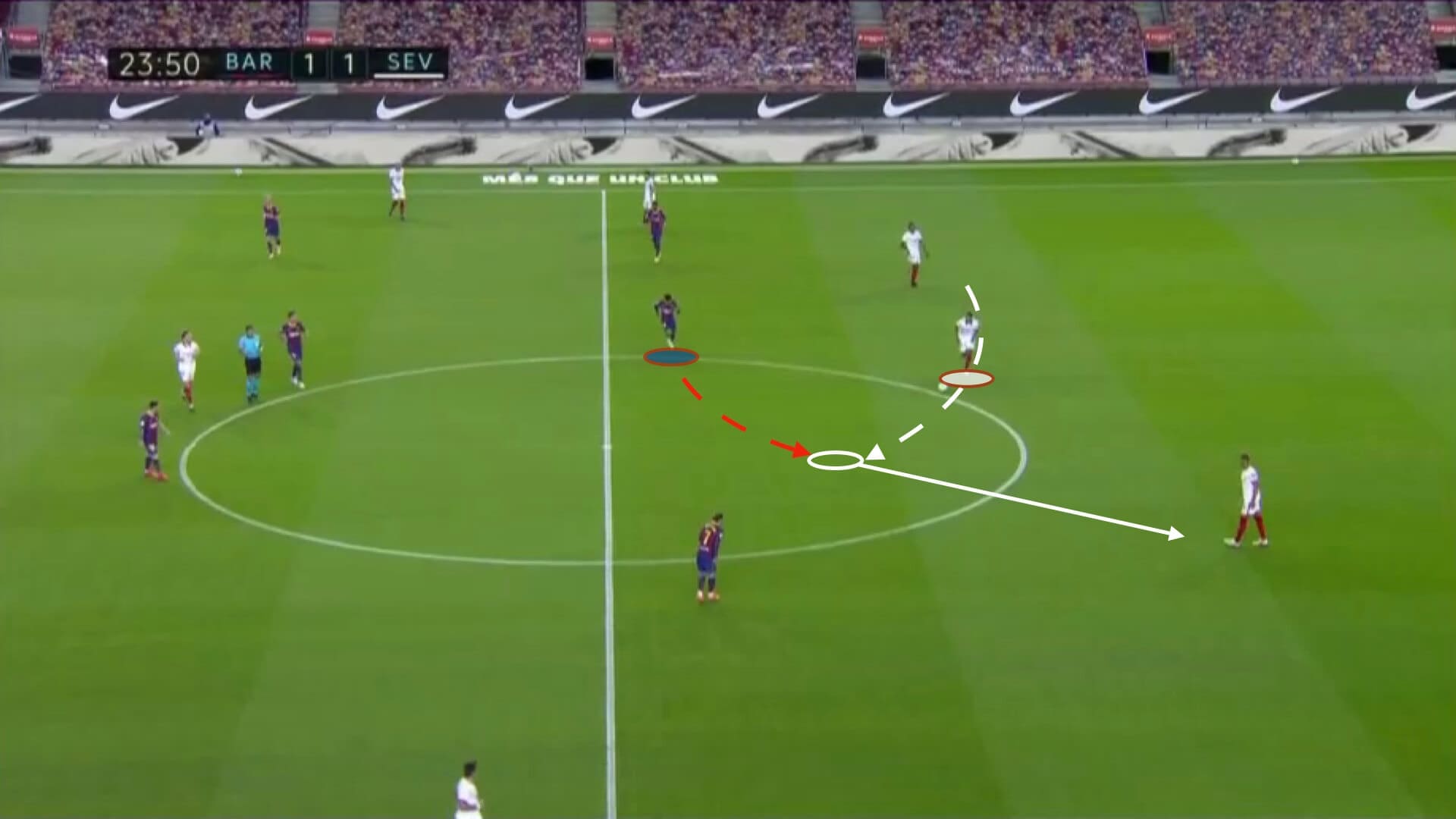
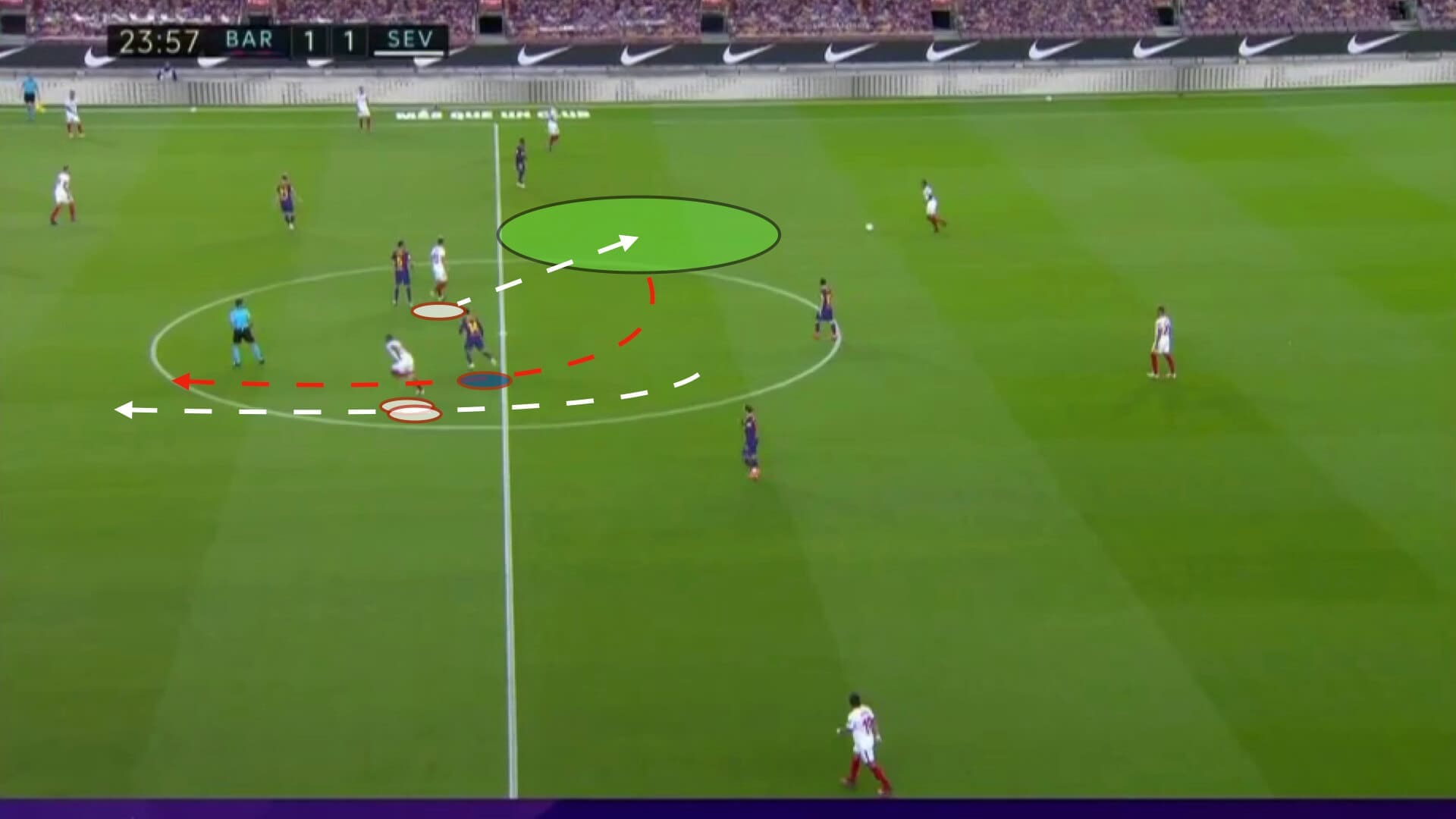
And another example of these movements can be seen below. Fernando again is positioned in advanced positions, with Coutinho near him, while Rakitic and Jordán come deeper and attract both Barcelona’s defensive midfielders. Luuk De Jong also drops deep and forces Piqué to follow him out of his position or leave Coutinho defending both him and Fernando.
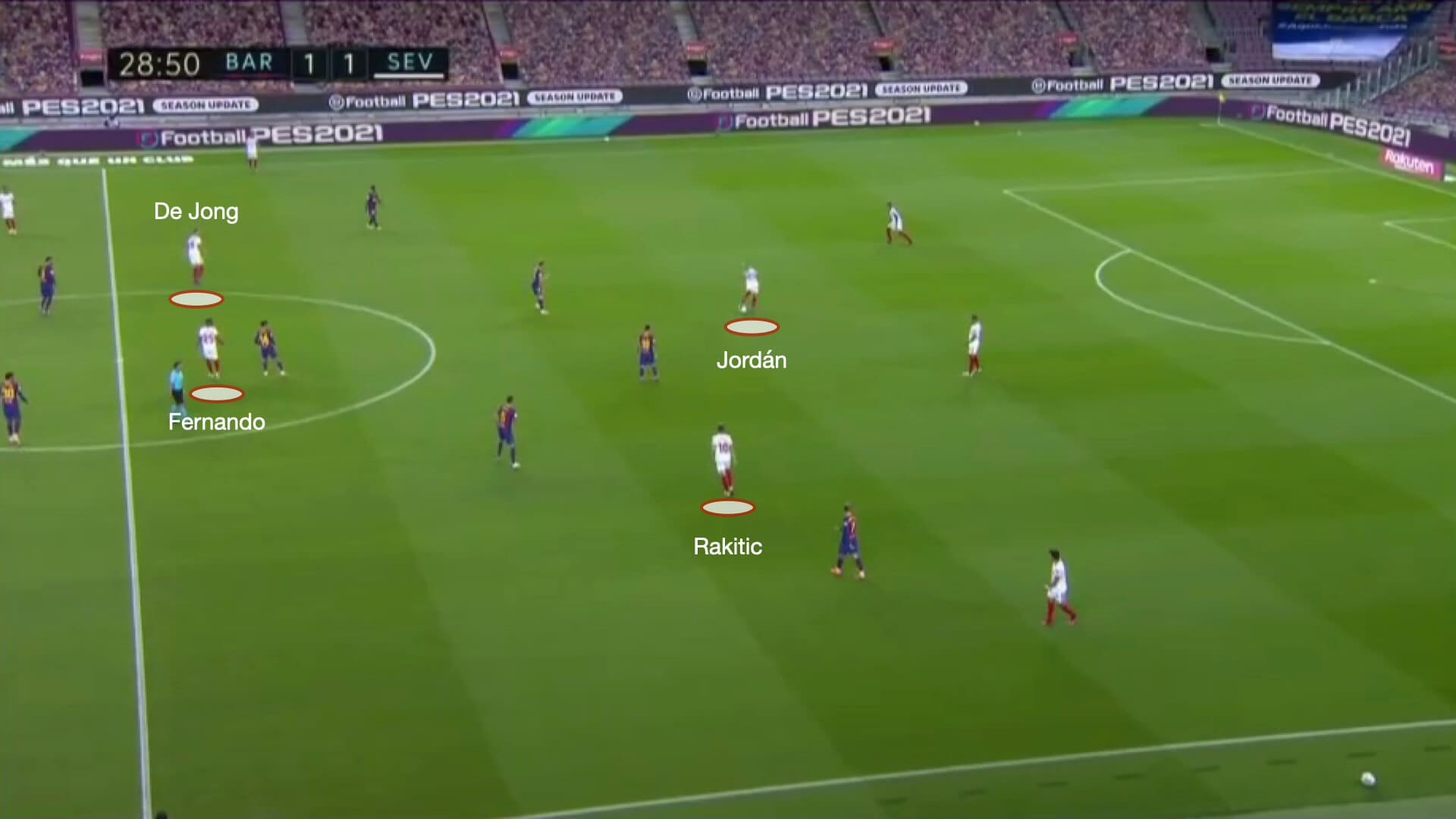
Sevilla’s movements were useful to beat Barcelona’s pressure, but they didn’t create a lot from open play. In fact, they only produced 0.28 xG from five shots in open play with the resting 0.97 xG and five shots coming from corner kicks. Again, aerial power was key for Sevilla, but there was a trend Barcelona could have spotted to avoid conceding the goal.
In the first minutes of the game, Sevilla took advantage of Barcelona’s positional naivety when defending corner kicks, taking two quick short ones which resulted in the two most dangerous chances in the game (0.34 and 0.27 xG) and in their only goal. In the following pictures, we see both corner kicks and how much space Barcelona conceded for the cross, the second one being the goal. In both cases, it was Fati who should have reacted earlier to stop the cross, but he would also have needed someone with him as they were 2v1 situations.
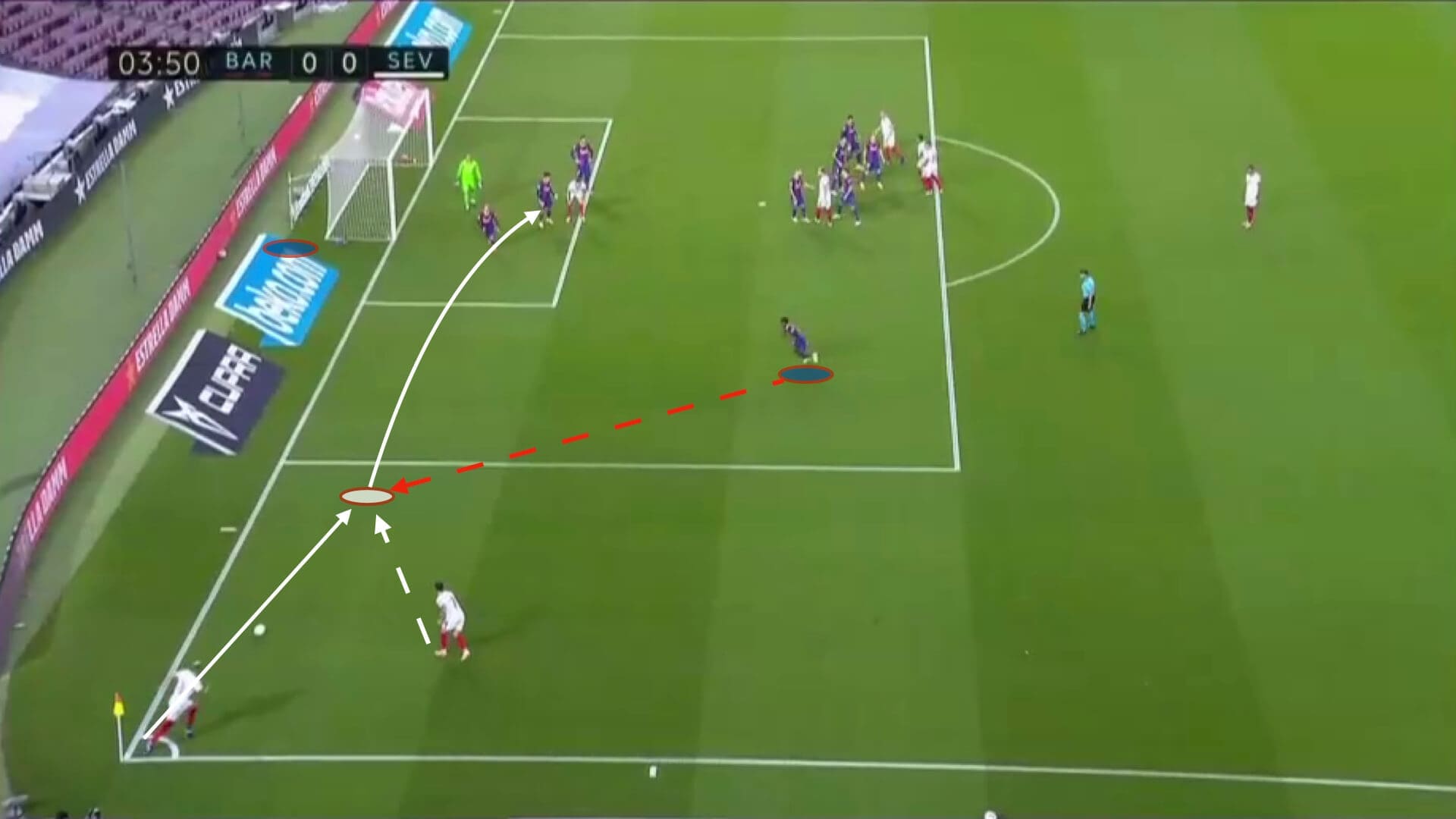
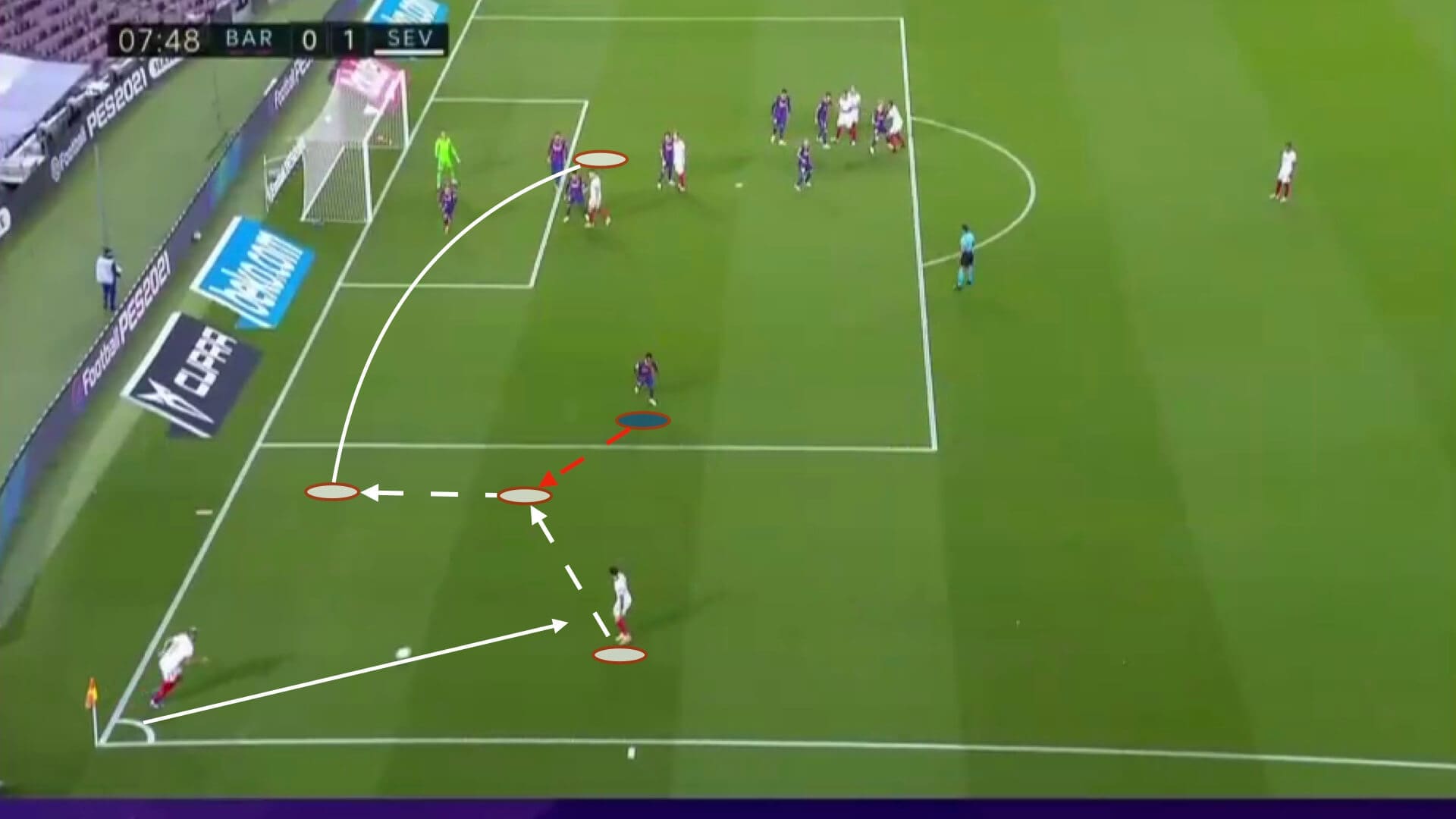
Sevilla changed very effectively between a high press and a very effective low block. The later completely impeded Barcelona from playing between the lines, as the two triangles formed by the centre-backs and Fernando and by Fernando and the two central midfielders were very compact and didn’t concede any spaces. Fernando even dropped between the centre-backs at some points, making it even harder for Barcelona to find any spaces near the edge of the box.
We can see this defensive disposition in the picture below, with the full-backs also very close to the centre-backs and the wingers also defending very deep. Sevilla forced Barcelona to the wings, where they lacked dribbling ability. Barcelona only completed ten dribbles in the match, with Coutinho, Alba, Roberto, Griezmann and Pedri completing no dribbles, Trincão and Fati one each and Messi five.
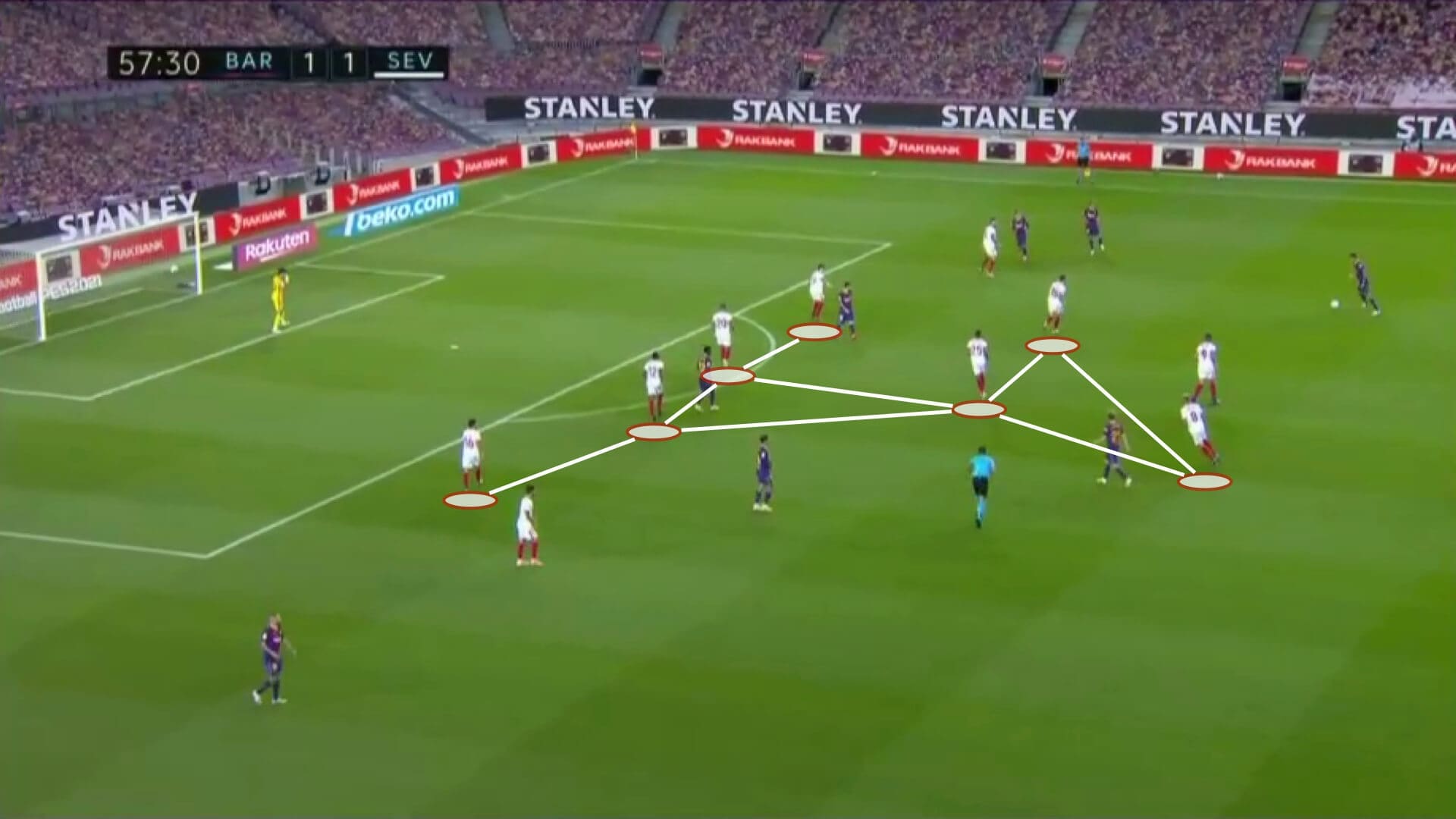
Changes didn’t affect Sevilla positively. En Nesyri and Munir came in for Ocampos and Suso, so Sevilla lost quality and gained pace, but it wasn’t effective as Barcelona controlled the ball in the last minutes and they couldn’t get any chances in the counterattacks. In the last 15 minutes, Gudelj came in for Rakitic to defend the draw.
Conclusion
An under-construction FC Barcelona faced one of the best teams in La Liga at the moment and couldn’t show any superiority. Sevilla proved to be a very solid and flexible team, capable of adapting to various demands throughout the game and limited Barcelona to few chances, deserving the point they got from the Camp Nou.
Going forward, both clubs can take positives from this game. Barcelona were solid in defence except for corner kicks as we have seen in this tactical analysis and even if their pressing wasn’t the best, they have improved their positional defence respect to last season, especially compared to their performances in the UEFA Champions League. On the other side, Sevilla proved once again they can compete against Europe’s top teams and presented themselves as title contenders in this season’s La Liga.





Comments